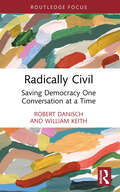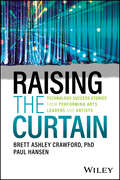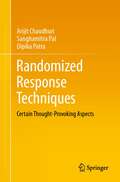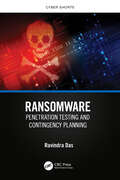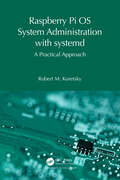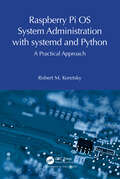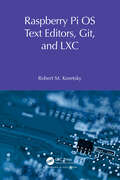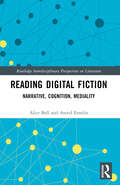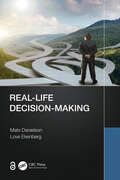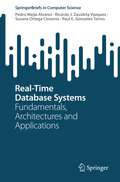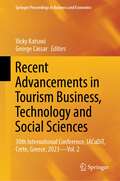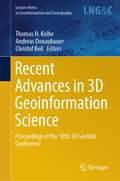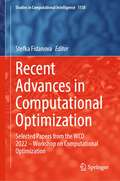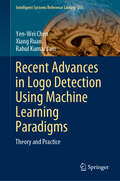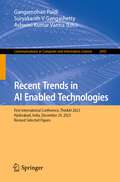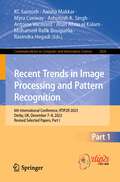- Table View
- List View
Radically Civil: Saving Democracy One Conversation at a Time (Routledge Research in Political Communication)
by Robert Danisch William KeithIf you feel like the world has gone to hell in a handbasket, you’re not alone. If you often feel there’s nothing you can do about it, you’re also not alone. Along with this increasing anger, fear, and frustration, much confusion still prevails on the appropriate communication practices for responding to difficult situations and improving our lives. Communication experts, Robert Danisch and William Keith, explain why and how we can practice radical civility in this practical guide to everyday “political” communication. This guide begins with examples of radical civility to show the potential of this kind of communication to change minds and bridge differences. The authors then unpack the three foundational principles of radical civility as useful theoretical tools for thinking throughout interactions with others in civic spaces. This is then followed by a three-step process for practicing radical civility drawing on research into active listening and its importance for creating connections, validating other views, and opening up possibilities for future conversation. The guide concludes with evidence-based communication practices and prescriptive recommendations for how to do each and show examples of each in action. Radically Civil: Saving Democracy One Conversation at a Time is a much-needed communication-based antidote to polarization, preparing students, researchers, and community leaders to be responsible participants in today’s society.
Radically Civil: Saving Democracy One Conversation at a Time (Routledge Research in Political Communication)
by Robert Danisch William KeithIf you feel like the world has gone to hell in a handbasket, you’re not alone. If you often feel there’s nothing you can do about it, you’re also not alone. Along with this increasing anger, fear, and frustration, much confusion still prevails on the appropriate communication practices for responding to difficult situations and improving our lives. Communication experts, Robert Danisch and William Keith, explain why and how we can practice radical civility in this practical guide to everyday “political” communication. This guide begins with examples of radical civility to show the potential of this kind of communication to change minds and bridge differences. The authors then unpack the three foundational principles of radical civility as useful theoretical tools for thinking throughout interactions with others in civic spaces. This is then followed by a three-step process for practicing radical civility drawing on research into active listening and its importance for creating connections, validating other views, and opening up possibilities for future conversation. The guide concludes with evidence-based communication practices and prescriptive recommendations for how to do each and show examples of each in action. Radically Civil: Saving Democracy One Conversation at a Time is a much-needed communication-based antidote to polarization, preparing students, researchers, and community leaders to be responsible participants in today’s society.
Raising the Curtain: Technology Success Stories from Performing Arts Leaders and Artists
by Brett Ashley Crawford Paul HansenLearn how emerging technologies benefit artists and performing arts organizations Raising the Curtain: Technology Success Stories from Performing Arts Leaders and Artists focuses on empowering artists and performing arts organizations in theater, dance, and music to grow audiences and to increase impact through smart and strategic uses of technology. This book will help you effectively increase your artistic and administrative reach in order to expand your outreach to diverse audiences, without breaking the bank. In fact, you’ll be more efficient by choosing multi-function technologies that work for you. You’ll also see how advanced software can extend your donor reach—and ensure that you’re contacting donors at the right time. You can also maximize your organization’s brand by incorporating social media, AI tools, media streaming platforms, and more. Inside, you’ll learn about the most useful tech tools out there, including a wide breadth of technology, from Tessitura to A.I., from the success stories of artists such as Emmet Cohen and Jane Monheit, and organizations such as Attack Theatre and The Kennedy Center. Even more importantly, you’ll gain the confidence you need to incorporate technology into all areas of your organization in order to define your path to greater success. Discover software platforms, online tools, and other interactive technologies useful to designers, artists, and arts organizations Save money, expand your reach, and future-proof your performing arts organization or career Lead conversations about technologies and digital opportunities with staff, board members, or donors Get an overview of technology that addresses the unique opportunities and challenges facing the performing arts industry This book is a great resource for performing arts administrators and artists to learn new ideas about technology solutions. Administrators, leaders, and performers alike will appreciate the opportunity to bring art to audiences using today’s latest innovations.
Raising the Curtain: Technology Success Stories from Performing Arts Leaders and Artists
by Brett Ashley Crawford Paul HansenLearn how emerging technologies benefit artists and performing arts organizations Raising the Curtain: Technology Success Stories from Performing Arts Leaders and Artists focuses on empowering artists and performing arts organizations in theater, dance, and music to grow audiences and to increase impact through smart and strategic uses of technology. This book will help you effectively increase your artistic and administrative reach in order to expand your outreach to diverse audiences, without breaking the bank. In fact, you’ll be more efficient by choosing multi-function technologies that work for you. You’ll also see how advanced software can extend your donor reach—and ensure that you’re contacting donors at the right time. You can also maximize your organization’s brand by incorporating social media, AI tools, media streaming platforms, and more. Inside, you’ll learn about the most useful tech tools out there, including a wide breadth of technology, from Tessitura to A.I., from the success stories of artists such as Emmet Cohen and Jane Monheit, and organizations such as Attack Theatre and The Kennedy Center. Even more importantly, you’ll gain the confidence you need to incorporate technology into all areas of your organization in order to define your path to greater success. Discover software platforms, online tools, and other interactive technologies useful to designers, artists, and arts organizations Save money, expand your reach, and future-proof your performing arts organization or career Lead conversations about technologies and digital opportunities with staff, board members, or donors Get an overview of technology that addresses the unique opportunities and challenges facing the performing arts industry This book is a great resource for performing arts administrators and artists to learn new ideas about technology solutions. Administrators, leaders, and performers alike will appreciate the opportunity to bring art to audiences using today’s latest innovations.
Randomized Response Techniques: Certain Thought-Provoking Aspects
by Arijit Chaudhuri Sanghamitra Pal Dipika PatraThis book presents an up-to-date perspective on randomized response techniques (RRT). It discusses the most appropriate and efficient procedures of RRT for analysing data from queries dealing with sensitive and confidential issues, including the treatment of infinite and finite population setups. The book aims to spark a renewed interest among sampling experts who may have overlooked RRT. By addressing the missing topics and incorporating a wide range of contributors' works, it seeks to foster an appreciative academic environment and inspire a reformed and amended view of RRT. As the book unfolds, readers will gain valuable insights into the evolving landscape of RRT and its applications, positioning them at the forefront of this engaging field of study.On RRT, the literature has grown immensely since its inception in 1965 by S.L. Warner. Despite several books published on the subject, there are still two crucial topics missing from the existing RRT literature. This book aimsto address these gaps and provide valuable insights to curious readers in the field. The book is mandatory reading for statisticians and biostatisticians, market researchers, operations researchers, pollsters, sociologists, political scientists, economists and advanced undergraduate and graduate students in these areas.
Ransomware: Penetration Testing and Contingency Planning (Cyber Shorts)
by Ravindra DasRansomware is a threat variant that has existed for a very long time, contrary to popular belief. Today, ransomware attacks have become much more covert and stealthier than when they first came out. In this book, the author provides an overview of ransomware and the timeline of its evolution. The author also discusses famous ransomware attacks that have occurred, with a special focus on SolarWinds and critical infrastructure before taking a deep dive into penetration testing and how it can be used to mitigate the risks of a ransomware attack from happening. The author also covers incident response, disaster recovery, and business continuity planning. We even look at an appropriate data backup plan as well.
Ransomware: Penetration Testing and Contingency Planning (Cyber Shorts)
by Ravindra DasRansomware is a threat variant that has existed for a very long time, contrary to popular belief. Today, ransomware attacks have become much more covert and stealthier than when they first came out. In this book, the author provides an overview of ransomware and the timeline of its evolution. The author also discusses famous ransomware attacks that have occurred, with a special focus on SolarWinds and critical infrastructure before taking a deep dive into penetration testing and how it can be used to mitigate the risks of a ransomware attack from happening. The author also covers incident response, disaster recovery, and business continuity planning. We even look at an appropriate data backup plan as well.
Raspberry Pi OS System Administration with systemd: A Practical Approach (Raspberry Pi OS System Administration with systemd)
by Robert M. KoretskyThe first in a new series exploring the basics of Raspberry Pi Operating System (OS) administration, this volume is a compendium of easy-to-use and essential system administration for the novice user of the Raspberry Pi OS. The overriding idea behind the system administration of a modern, 21st-century Linux system such as the Raspberry Pi OS is the use of systemd to ensure that the Linux kernel works efficiently and effectively to provide the three foundation stones of computer operation and management: computer system concurrency, virtualization, and secure persistence. Exercises are included throughout to reinforce the readers’ learning goals with solutions and example code provided on the accompanying GitHub site. This book is aimed at students and practitioners looking to maximize their use of the Raspberry Pi OS. With plenty of practical examples, projects, and exercises, this volume can also be adopted in a more formal learning environment to supplement and extend the basic knowledge of a Linux operating system.
Raspberry Pi OS System Administration with systemd: A Practical Approach (Raspberry Pi OS System Administration with systemd)
by Robert M. KoretskyThe first in a new series exploring the basics of Raspberry Pi Operating System (OS) administration, this volume is a compendium of easy-to-use and essential system administration for the novice user of the Raspberry Pi OS. The overriding idea behind the system administration of a modern, 21st-century Linux system such as the Raspberry Pi OS is the use of systemd to ensure that the Linux kernel works efficiently and effectively to provide the three foundation stones of computer operation and management: computer system concurrency, virtualization, and secure persistence. Exercises are included throughout to reinforce the readers’ learning goals with solutions and example code provided on the accompanying GitHub site. This book is aimed at students and practitioners looking to maximize their use of the Raspberry Pi OS. With plenty of practical examples, projects, and exercises, this volume can also be adopted in a more formal learning environment to supplement and extend the basic knowledge of a Linux operating system.
Raspberry Pi OS System Administration with systemd and Python: A Practical Approach
by Robert M. KoretskyThe second in a new series exploring the basics of Raspberry Pi Operating System administration, this installment builds on the insights provided in Volume 1 to provide a compendium of easy-to-use and essential Raspberry Pi OS system administration for the novice user, with specific focus on Python and Python3. The overriding idea behind system administration of a modern, 21st-century Linux system such as the Raspberry Pi OS is the use of systemd to ensure that the Linux kernel works efficiently and effectively to provide these three foundation stones of computer operation and management: computer system concurrency, virtualization, and secure persistence. Exercises are included throughout to reinforce the readers’ learning goals with solutions and example code provided on the accompanying GitHub site. This book is aimed at students and practitioners looking to maximize their use of the Raspberry Pi OS. With plenty of practical examples, projects, and exercises, this volume can also be adopted in a more formal learning environment to supplement and extend the basic knowledge of a Linux operating system.
Raspberry Pi OS System Administration with systemd and Python: A Practical Approach
by Robert M. KoretskyThe second in a new series exploring the basics of Raspberry Pi Operating System administration, this installment builds on the insights provided in Volume 1 to provide a compendium of easy-to-use and essential Raspberry Pi OS system administration for the novice user, with specific focus on Python and Python3. The overriding idea behind system administration of a modern, 21st-century Linux system such as the Raspberry Pi OS is the use of systemd to ensure that the Linux kernel works efficiently and effectively to provide these three foundation stones of computer operation and management: computer system concurrency, virtualization, and secure persistence. Exercises are included throughout to reinforce the readers’ learning goals with solutions and example code provided on the accompanying GitHub site. This book is aimed at students and practitioners looking to maximize their use of the Raspberry Pi OS. With plenty of practical examples, projects, and exercises, this volume can also be adopted in a more formal learning environment to supplement and extend the basic knowledge of a Linux operating system.
Raspberry Pi OS Text Editors, git, and LXC: A Practical Approach (Raspberry Pi OS System Administration with systemd)
by Robert M KoretskyThe third volume in a new series exploring the basics of Raspberry Pi Operating System administration, this installment builds on the insights from Volumes 1 and 2 to provide a compendium of easy-to-use and essential guidance for Raspberry Pi system administration for novice users, with specific focus on Text Editors, git/ GitHub, and LXC/LXD.The overriding idea behind system administration of a modern, 21st-century Linux system, such as the Raspberry Pi OS, is the use of systemd to ensure that the Linux kernel works efficiently and effectively to provide these three foundation stones of computer operation and management: computer system concurrency, virtualization, and secure persistence. This third volume includes a beginner’s compendium of essential text-based Linux commands, a complete tutorial on the most important Raspberry Pi OS Text Editors, a description of uses of the git command, and a thorough explication of container virtualization with LXC/LXD and Docker.This book is aimed at students and practitioners looking to maximize their use of the Raspberry Pi OS. With plenty of practical examples, projects, and exercises, this volume can also be adopted in a more formal learning environment to supplement and extend the basic knowledge of a Linux operating system.
Raspberry Pi OS Text Editors, git, and LXC: A Practical Approach (Raspberry Pi OS System Administration with systemd)
by Robert M KoretskyThe third volume in a new series exploring the basics of Raspberry Pi Operating System administration, this installment builds on the insights from Volumes 1 and 2 to provide a compendium of easy-to-use and essential guidance for Raspberry Pi system administration for novice users, with specific focus on Text Editors, git/ GitHub, and LXC/LXD.The overriding idea behind system administration of a modern, 21st-century Linux system, such as the Raspberry Pi OS, is the use of systemd to ensure that the Linux kernel works efficiently and effectively to provide these three foundation stones of computer operation and management: computer system concurrency, virtualization, and secure persistence. This third volume includes a beginner’s compendium of essential text-based Linux commands, a complete tutorial on the most important Raspberry Pi OS Text Editors, a description of uses of the git command, and a thorough explication of container virtualization with LXC/LXD and Docker.This book is aimed at students and practitioners looking to maximize their use of the Raspberry Pi OS. With plenty of practical examples, projects, and exercises, this volume can also be adopted in a more formal learning environment to supplement and extend the basic knowledge of a Linux operating system.
Read Write Own: Building the Next Era of the Internet
by Chris Dixon‘A compelling vision of where the internet should go and how to get there.’ Sam Altman, CEO, OpenAI_A potent exploration of the power of blockchains to reshape the future of the internet – and how that affects us all – from technology entrepreneur and startup investor Chris Dixon.The internet of today is a far cry from its early promise of a decentralized, democratic network of innovation, connection and freedom. In the past decade, it has fallen almost entirely under the control of a very small group of companies like Apple, Google, and Facebook.In Read Write Own, tech visionary Chris Dixon argues that the dream of a creative, entrepreneurial internet doesn’t have to die and can, in fact, be saved with blockchain networks. He separates this movement, which aims to provide a solid foundation for everything from social networks to artificial intelligence to virtual worlds, from cryptocurrency speculation – a distinction he calls ‘the computer vs the casino’.Drawing on a 25-year career in the software industry, Dixon lucidly shows how the history of the internet has been defined by three distinct eras that have brought us to the critical moment we’re in today. The first was the ‘read’ era, in which early networks democratized information. The second was the ‘read-write’ era, in which corporate networks democratized publishing. We are now in the midst of the ‘read-write-own’ era, sometimes called web3, in which blockchain networks are granting power and economic benefits to communities of users, not just corporations.Read Write Own is a must-read for anyone – internet users, business leaders, creators, entrepreneurs – who wants to understand where we’ve been and where we’re going. It provides a vision for a better internet and a playbook to navigate and build the future.‘A must for anyone who wants to better understand the real potential of blockchains and web3 to drive even greater innovation.’ Robert Iger, CEO, Disney'Fascinating . . . a refreshing and radical new take at a time when we need fresh thinking more than ever.' Mustafa Suleyman, co-founder of DeepMind and author of The Coming Wave
Reading Digital Fiction: Narrative, Cognition, Mediality (Routledge Interdisciplinary Perspectives on Literature)
by Alice Bell Astrid EnsslinReading Digital Fiction offers the first comprehensive and systematic theoretical, methodological, and analytical examination of digital fiction from a cognitive and empirical perspective. Proposing the new concept of “medial reading”, it argues for the centrality of an audience’s interest in, awareness of and/or attention to the medium in which a text is produced and received, and which we argue should be applied to reader data across media. The book analyses and theorises five generations of digital fiction and their reading including hypertext fiction, hypermedia fiction, narrative video games, app fiction, and virtual reality. It showcases medium- and platform-specific methods of qualitative reader response research across a variety of contexts and settings from screen-based and embodied interaction to gallery installation, and from reading group and individual interview to think-aloud methodologies. The book thus addresses the unique affordances of digital fiction reading by designing and reporting on new empirical studies focusing on hypertextuality, interactivity, immersion, as well as medium-specific forms of textual “you”, ontological ambiguity, reader orientation and empathy. In so doing, the book refines, critiques, and expands cognitive, transmedial, and empirical narratology and stylistics by placing the reader of these new narratives front and centre.
Reading Digital Fiction: Narrative, Cognition, Mediality (Routledge Interdisciplinary Perspectives on Literature)
by Alice Bell Astrid EnsslinReading Digital Fiction offers the first comprehensive and systematic theoretical, methodological, and analytical examination of digital fiction from a cognitive and empirical perspective. Proposing the new concept of “medial reading”, it argues for the centrality of an audience’s interest in, awareness of and/or attention to the medium in which a text is produced and received, and which we argue should be applied to reader data across media. The book analyses and theorises five generations of digital fiction and their reading including hypertext fiction, hypermedia fiction, narrative video games, app fiction, and virtual reality. It showcases medium- and platform-specific methods of qualitative reader response research across a variety of contexts and settings from screen-based and embodied interaction to gallery installation, and from reading group and individual interview to think-aloud methodologies. The book thus addresses the unique affordances of digital fiction reading by designing and reporting on new empirical studies focusing on hypertextuality, interactivity, immersion, as well as medium-specific forms of textual “you”, ontological ambiguity, reader orientation and empathy. In so doing, the book refines, critiques, and expands cognitive, transmedial, and empirical narratology and stylistics by placing the reader of these new narratives front and centre.
Real-Life Decision-Making
by Mats Danielson Love EkenbergHave you ever experienced a decision situation that was hard to come to grips with? Did you ever feel a need to improve your decision-making skills? Is this something where you feel that you have not learned enough practical and useful methods? In that case, you are not alone! Even though decision-making is both considered and actually is a very important skill in modern work-life as well as in private life, these skills are not to any reasonable extent taught in schools at any level. No wonder many people do indeed feel the need to improve but have a hard time finding out how. This book is an attempt to remedy this shortcoming of our educational systems and possibly also of our common, partly intuition-based, decision culture. Intuition is not at all bad, quite the contrary, but it has to co-exist with rationality. We will show you how.Methods for decision-making should be of prime concern to any individual or organisation, even if the decision processes are not always explicitly or even consciously formulated. All kinds of organisations, as well as individuals, must continuously make decisions of the most varied nature in order to prosper and attain their objectives. A large part of the time spent in any organisation, not least at management levels, is spent gathering, processing, and compiling information for the purpose of making decisions supported by that information. The same interest has hitherto not been shown for individual decision-making, even though large gains would also be obtained at a personal level if important personal decisions were better deliberated. This book aims at changing that and thus attends to both categories of decision-makers.This book will take you through a journey starting with some history of decision-making and analysis and then go through easy-to-learn ways of structuring decision information and methods for analysing the decision situations, beginning with simple decision situations and then moving on to progressively harder ones, but never losing sight of the overarching goal that the reader should be able to follow the progression and being able to carry out similar decision analyses in real-life situations.The Open Access version of this book, available at www.taylorfrancis.com, has been made available under a Creative Commons Attribution-Non Commercial-No Derivatives 4.0 license.
Real-Life Decision-Making
by Mats Danielson Love EkenbergHave you ever experienced a decision situation that was hard to come to grips with? Did you ever feel a need to improve your decision-making skills? Is this something where you feel that you have not learned enough practical and useful methods? In that case, you are not alone! Even though decision-making is both considered and actually is a very important skill in modern work-life as well as in private life, these skills are not to any reasonable extent taught in schools at any level. No wonder many people do indeed feel the need to improve but have a hard time finding out how. This book is an attempt to remedy this shortcoming of our educational systems and possibly also of our common, partly intuition-based, decision culture. Intuition is not at all bad, quite the contrary, but it has to co-exist with rationality. We will show you how.Methods for decision-making should be of prime concern to any individual or organisation, even if the decision processes are not always explicitly or even consciously formulated. All kinds of organisations, as well as individuals, must continuously make decisions of the most varied nature in order to prosper and attain their objectives. A large part of the time spent in any organisation, not least at management levels, is spent gathering, processing, and compiling information for the purpose of making decisions supported by that information. The same interest has hitherto not been shown for individual decision-making, even though large gains would also be obtained at a personal level if important personal decisions were better deliberated. This book aims at changing that and thus attends to both categories of decision-makers.This book will take you through a journey starting with some history of decision-making and analysis and then go through easy-to-learn ways of structuring decision information and methods for analysing the decision situations, beginning with simple decision situations and then moving on to progressively harder ones, but never losing sight of the overarching goal that the reader should be able to follow the progression and being able to carry out similar decision analyses in real-life situations.The Open Access version of this book, available at www.taylorfrancis.com, has been made available under a Creative Commons Attribution-Non Commercial-No Derivatives 4.0 license.
Real-Time Database Systems: Fundamentals, Architectures and Applications (SpringerBriefs in Computer Science)
by Pedro Mejia Alvarez Ricardo J. Zavaleta Vazquez Susana Ortega Cisneros Raul E. Gonzalez TorresThis book provides an overview of both experimental and commercial real-time database systems (RTDBs) and a systematic approach to understanding, designing, and implementing them. To this end, the book is composed of four chapters: Chapter 1 “An Overview of Real-Time Database Systems” delves into the realm of RTDBs and discusses the specific requirements, transaction models, and scheduling algorithms that set RTDBs apart from conventional DBMs. Chapter 2 on “Experimental Real-Time Databases” presents various experimental RTDBs developed in academia with their architectures, features, and implementations, while chapter 3 on “Commercial Real-Time Databases” does so for systems developed and offered by commercial vendors as products or services. Eventually, chapter 4 on “Applications of Real-Time Database Systems” showcases various applications of RTDBs across different domains. This book will help researchers, graduate students and advanced professionals to get an overview of the area and to understand the main challenges and systems available.
Recent Advancements in Tourism Business, Technology and Social Sciences: 10th International Conference, IACuDiT, Crete, Greece, 2023 - Vol. 2 (Springer Proceedings in Business and Economics)
by Vicky Katsoni George CassarThe book features the second volume of the proceedings of the 10th International Conference of the International Association of Cultural and Digital Tourism (IACuDiT), with the theme “Recent Advancements in Tourism Business, Technology, and Social Sciences,” which was held from August 29 to 31, 2023, in Crete, Greece. It showcases the latest research on Tourism Business, Technology, and Social Sciences and presents a critical academic discourse on smart and sustainable practices in the tourism industry, stimulating future debates and advancing readers’ knowledge and understanding of this critical area of tourism business in the post-COVID-19 era. COVID-19 produced dramatic effects on the global economy, business activities, and people, with tourism being particularly affected. The book discusses the resulting digital transformation process in a range of areas, including its effect on the social sciences combined with special forms of tourism. This accelerated digitalizationencourages the emergence of new digital products and services based on the principle of flexibility. The book focuses on the knowledge economy and smart destinations, as well as new modes of tourism management and development, and includes chapters on emerging technologies such as the Internet of Things, artificial intelligence, big data, and robotics in connection with various tourism practices.
Recent Advances in 3D Geoinformation Science: Proceedings of the 18th 3D GeoInfo Conference (Lecture Notes in Geoinformation and Cartography)
by Thomas H. Kolbe Andreas Donaubauer Christof BeilThe book includes the contributions to the international conference “18th 3D GeoInfo”. The papers published in the book were selected through a double-blind review process. 3D GeoInfo has been the forum joining researchers, professionals, software developers, and data providers designing and developing innovative concepts, tools, and application related to 3D geo data processing, modeling, management, analytics, and simulation. A big focus is on topics related to data modeling for 3D city and landscape models as well as their many and diverse applications. This conference series is very successfully running since 2006 and has been hosted by countries in Europe, Asia, Africa, North America, and Australia. In the period 2006 to 2017, the proceedings has been published by Springer in this series with Thomas H. Kolbe being the editor of the 2010 edition of the conference proceedings. 18th 3DGeoInfo was organized by Technical University of Munich in cooperation with the German Society for Photogrammetry, Remote Sensing and Geoinformation (DGPF), the local associations Runder Tisch GIS e.V. (Round Table GIS) and Leonhard Obermeyer Center—TUM Center of Digital Methods for the Built Environment, and the City of Munich. The international program committee consisted of committee members of previous 3D GeoInfo conferences and further leading scientists in the field of 3D Geoinformation Science.
Recent Advances in Computational Optimization: Selected Papers from the WCO 2022 – Workshop on Computational Optimization (Studies in Computational Intelligence #1158)
by Stefka FidanovaThe book is a comprehensive collection of extended contributions from the Workshops on Computational Optimization 2022. Our everyday life is unthinkable without optimization. We try to minimize our effort and to maximize the achieved profit. Many real world and industrial problems arising in engineering, economics, medicine, and other domains can be formulated as optimization tasks. This book presents recent advances in computational optimization. The book includes important real problems like modeling of physical processes, parameter settings for controlling different processes, agricultural modeling transportation problems, energy management, machine scheduling, air pollution modeling, optimization of fast-food restaurant chain, and solving engineering and financial problems. It shows how to develop algorithms for them based on new intelligent methods like evolutionary computations, ant colony optimization, constrain programming Monte Carlo method, and others. This book demonstrates how some real-world problems arising in engineering, economics, and other domains can be formulated as optimization problems.
Recent Advances in Logo Detection Using Machine Learning Paradigms: Theory and Practice (Intelligent Systems Reference Library #255)
by Yen-Wei Chen Xiang Ruan Rahul Kumar JainThis book presents the current trends in deep learning-based object detection framework with a focus on logo detection tasks. It introduces a variety of approaches, including attention mechanisms and domain adaptation for logo detection, and describes recent advancement in object detection frameworks using deep learning. We offer solutions to the major problems such as the lack of training data and the domain-shift issues. This book provides numerous ways that deep learners can use for logo recognition, including: Deep learning-based end-to-end trainable architecture for logo detection Weakly supervised logo recognition approach using attention mechanisms Anchor-free logo detection framework combining attention mechanisms to precisely locate logos in the real-world images Unsupervised logo detection that takes into account domain-shift issues from synthetic to real-world images Approach for logo detection modeling domain adaption task in the context of weakly supervised learning to overcome the lack of object-level annotation problem. The merit of our logo recognition technique is demonstrated using experiments, performance evaluation, and feature distribution analysis utilizing different deep learning frameworks. The book is directed to professors, researchers, practitioners in the field of engineering, computer science, and related fields as well as anyone interested in using deep learning techniques and applications in logo and various object detection tasks.
Recent Trends in AI Enabled Technologies: First International Conference, ThinkAI 2023, Hyderabad, India, December 29, 2023, Revised Selected Papers (Communications in Computer and Information Science #2045)
by Gangamohan Paidi Suryakanth V Gangashetty Ashwini Kumar VarmaThis book constitutes the refereed proceedings of the First International Conference on Recent Trends in AI Enabled Technologies, ThinkAI 2023, which took place in Hyderabad, India, in December 2023. The 7 full papers presented in these proceedings were carefully reviewed and selected from 51 submissions. The conference focuses on on up to date topics and recent trends in artificial intelligence and related technologies.
Recent Trends in Image Processing and Pattern Recognition: 6th International Conference, RTIP2R 2023, Derby, UK, December 7–8, 2023, Revised Selected Papers, Part I (Communications in Computer and Information Science #2026)
by Kc Santosh Aaisha Makkar Myra Conway Ashutosh K. Singh Antoine Vacavant Anas Abou el Kalam Mohamed-Rafik Bouguelia Ravindra HegadiThis book constitutes the refereed proceedings of the 6th International Conference on Recent Trends in Image Processing and Pattern Recognition, RTIP2R 2023, held in Derby, UK, during December 2023, in collaboration with the Applied AI Research Lab at the University of South Dakota.The 62 full papers included in this book were carefully reviewed and selected from 216 submissions. The papers are organized in the following topical sections:Volume I:Artificial intelligence and applied machine learning; applied image processing and pattern recognition; and biometrics and applications.Volume II:Healthcare informatics; pattern recognition in blockchain, IOT, cyber plus network security, and cryptography.
